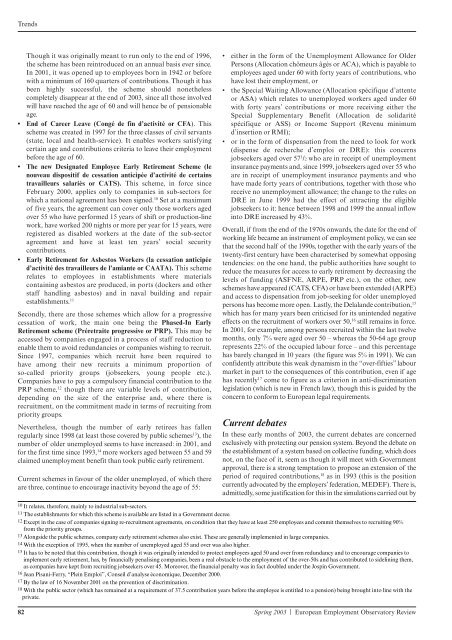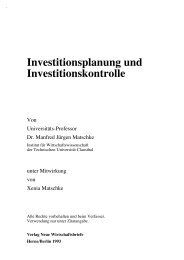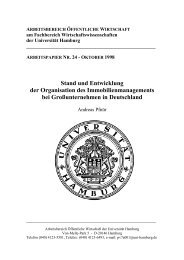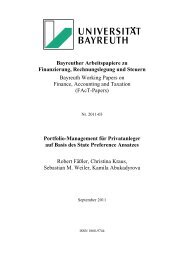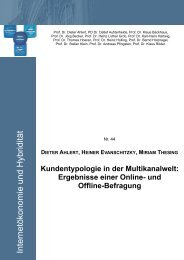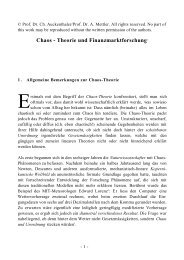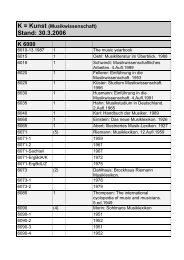FRANCE The
FRANCE The
FRANCE The
You also want an ePaper? Increase the reach of your titles
YUMPU automatically turns print PDFs into web optimized ePapers that Google loves.
Trends<br />
Though it was originally meant to run only to the end of 1996,<br />
the scheme has been reintroduced on an annual basis ever since.<br />
In 2001, it was opened up to employees born in 1942 or before<br />
with a minimum of 160 quarters of contributions. Though it has<br />
been highly successful, the scheme should nonetheless<br />
completely disappear at the end of 2003, since all those involved<br />
will have reached the age of 60 and will hence be of pensionable<br />
age.<br />
• End of Career Leave (Congé de fin d’activité or CFA). This<br />
scheme was created in 1997 for the three classes of civil servants<br />
(state, local and health-service). It enables workers satisfying<br />
certain age and contributions criteria to leave their employment<br />
before the age of 60.<br />
• <strong>The</strong> new Designated Employee Early Retirement Scheme (le<br />
nouveau dispositif de cessation anticipée d’activité de certains<br />
travailleurs salariés or CATS). This scheme, in force since<br />
February 2000, applies only to companies in sub-sectors for<br />
which a national agreement has been signed. 10 Set at a maximum<br />
of five years, the agreement can cover only those workers aged<br />
over 55 who have performed 15 years of shift or production-line<br />
work,have worked 200 nights or more per year for 15 years, were<br />
registered as disabled workers at the date of the sub-sector<br />
agreement and have at least ten years’ social security<br />
contributions.<br />
• Early Retirement for Asbestos Workers (la cessation anticipée<br />
d’activité des travailleurs de l’amiante or CAATA). This scheme<br />
relates to employees in establishments where materials<br />
containing asbestos are produced, in ports (dockers and other<br />
staff handling asbestos) and in naval building and repair<br />
establishments. 11<br />
Secondly, there are those schemes which allow for a progressive<br />
cessation of work, the main one being the Phased-In Early<br />
Retirement scheme (Préretraite progressive or PRP). This may be<br />
accessed by companies engaged in a process of staff reduction to<br />
enable them to avoid redundancies or companies wishing to recruit.<br />
Since 1997, companies which recruit have been required to<br />
have among their new recruits a minimum proportion of<br />
so-called priority groups (jobseekers, young people etc.).<br />
Companies have to pay a compulsory financial contribution to the<br />
PRP scheme, 12 though there are variable levels of contribution,<br />
depending on the size of the enterprise and, where there is<br />
recruitment, on the commitment made in terms of recruiting from<br />
priority groups.<br />
Nevertheless, though the number of early retirees has fallen<br />
regularly since 1998 (at least those covered by public schemes13 ), the<br />
number of older unemployed seems to have increased: in 2001, and<br />
for the first time since 1993, 14 more workers aged between 55 and 59<br />
claimed unemployment benefit than took public early retirement.<br />
Current schemes in favour of the older unemployed, of which there<br />
are three, continue to encourage inactivity beyond the age of 55:<br />
• either in the form of the Unemployment Allowance for Older<br />
Persons (Allocation chômeurs âgés or ACA), which is payable to<br />
employees aged under 60 with forty years of contributions, who<br />
have lost their employment, or<br />
• the Special Waiting Allowance (Allocation spécifique d’attente<br />
or ASA) which relates to unemployed workers aged under 60<br />
with forty years’ contributions or more receiving either the<br />
Special Supplementary Benefit (Allocation de solidarité<br />
spécifique or ASS) or Income Support (Revenu minimum<br />
d’insertion or RMI);<br />
• or in the form of dispensation from the need to look for work<br />
(dispense de recherche d’emploi or DRE): this concerns<br />
jobseekers aged over 571 /2 who are in receipt of unemployment<br />
insurance payments and, since 1999, jobseekers aged over 55 who<br />
are in receipt of unemployment insurance payments and who<br />
have made forty years of contributions, together with those who<br />
receive no unemployment allowance; the change to the rules on<br />
DRE in June 1999 had the effect of attracting the eligible<br />
jobseekers to it: hence between 1998 and 1999 the annual inflow<br />
into DRE increased by 43%.<br />
Overall, if from the end of the 1970s onwards, the date for the end of<br />
working life became an instrument of employment policy, we can see<br />
that the second half of the 1990s, together with the early years of the<br />
twenty-first century have been characterised by somewhat opposing<br />
tendencies: on the one hand, the public authorities have sought to<br />
reduce the measures for access to early retirement by decreasing the<br />
levels of funding (ASFNE, ARPE, PRP etc.), on the other, new<br />
schemes have appeared (CATS, CFA) or have been extended (ARPE)<br />
and access to dispensation from job-seeking for older unemployed<br />
persons has become more open. Lastly, the Delalande contribution, 15<br />
which has for many years been criticised for its unintended negative<br />
effects on the recruitment of workers over 50, 16 still remains in force.<br />
In 2001, for example, among persons recruited within the last twelve<br />
months, only 7% were aged over 50 – whereas the 50-64 age group<br />
represents 22% of the occupied labour force – and this percentage<br />
has barely changed in 10 years (the figure was 5% in 1991). We can<br />
confidently attribute this weak dynamism in the “over-fifties” labour<br />
market in part to the consequences of this contribution, even if age<br />
has recently17 come to figure as a criterion in anti-discrimination<br />
legislation (which is new in French law), though this is guided by the<br />
concern to conform to European legal requirements.<br />
Current debates<br />
In these early months of 2003, the current debates are concerned<br />
exclusively with protecting our pension system. Beyond the debate on<br />
the establishment of a system based on collective funding, which does<br />
not, on the face of it, seem as though it will meet with Government<br />
approval, there is a strong temptation to propose an extension of the<br />
period of required contributions, 18 as in 1993 (this is the position<br />
currently advocated by the employers’ federation, MEDEF). <strong>The</strong>re is,<br />
admittedly, some justification for this in the simulations carried out by<br />
10 It relates, therefore, mainly to industrial sub-sectors.<br />
11 <strong>The</strong> establishments for which this scheme is available are listed in a Government decree.<br />
12 Except in the case of companies signing re-recruitment agreements, on condition that they have at least 250 employees and commit themselves to recruiting 90%<br />
from the priority groups.<br />
13 Alongside the public schemes, company early retirement schemes also exist. <strong>The</strong>se are generally implemented in large companies.<br />
14 With the exception of 1995, when the number of unemployed aged 55 and over was also higher.<br />
15 It has to be noted that this contribution, though it was originally intended to protect employees aged 50 and over from redundancy and to encourage companies to<br />
implement early retirement, has, by financially penalising companies, been a real obstacle to the employment of the over-50s and has contributed to sidelining them,<br />
as companies have kept from recruiting jobseekers over 45. Moreover, the financial penalty was in fact doubled under the Jospin Government.<br />
16 Jean Pisani-Ferry, “Plein Emploi”, Conseil d’analyse économique, December 2000.<br />
17 By the law of 16 November 2001 on the prevention of discrimination.<br />
18 With the public sector (which has remained at a requirement of 37.5 contribution years before the employee is entitled to a pension) being brought into line with the<br />
private.<br />
82 Spring 2003 | European Employment Observatory Review


